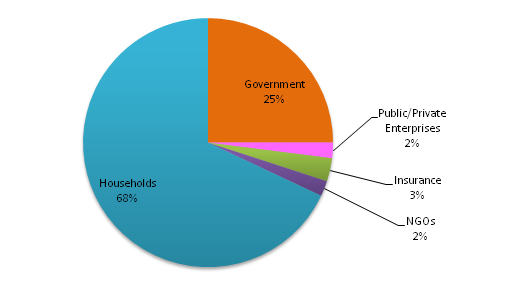As India aspires to establish itself as a global economic power, ensuring the health and well-being of its citizens is a crucial need. With this end in mind, what India needs right now is health care system which is not just comprehensive and accessible but also cost-efficient and scalable. Achieving these goals by itself would be a formidable task for the government, considering the state of our existing healthcare infrastructure, our rapidly growing population and the sheer geographical size of the country. This is where the private sector can play a key role.
The Need:
“Improvement of public health care” is mentioned as one of the primary duties of a state under the Indian Constitution. However, the numbers do not validate this fact. Despite state-driven healthcare facilities being nearly free of cost, national spending on health care is around 1% in India, much lower than other emerging nations. Also, fixed costs like salaries rather than equipment or facilities constitute a major chunk of this expenditure. This leads to dilution in the level of service, reach as well as capacity of government run health facilities. In addition, they are plagued by problems such as staff absenteeism, inadequate equipment and shortage of medical supplies.
Figure: Healthcare spend in India across different sectors
Avenues for collaboration:
As shown in the above graphic, household expenditure on healthcare is significantly greater than government expenditure, indicating popular preference of private medical care instead of the aging public health system. These private service providers include both for-profit and non-profit organizations and they collectively account for more than half of the hospitalizations. While they may not be a substitute for the public sector, involvement of the private sector is imminent to achieve health-related goals.
There are four key areas where private sector collaboration with public sector can prove to be highly beneficial – Infrastructure Creation, Health Insurance, Management & Operations and Medical Education.
Infrastructure Creation
Quality healthcare is a highly capital intensive business. The cost of a bed in a medical facility can be as high as 25 lakhs. Land and building costs account for close to 65% of the initial capital spend. Medical equipment, which are mostly imported are another major cost for hospitals. These capital costs and the resulting high prices for health care services make them unaffordable for a large segment of the population. As a consequence private players are highly circumspect about investing in health care, especially in non-urban areas.
The government can break this circle by incentivizing private investments subsidizing the cost of land. Import tax exemptions on medical equipment and tax relief for capital investments are other measures to encourage private investment in healthcare.
Health Insurance
With less than 10% of population insured, India has one of the lowest penetration levels of health insurance in the world. More than 50% of Indian healthcare spending is an ‘out of pocket’ expense, implying a serious risk to poor households who have to borrow money at exorbitant rates to pay for treatment. However, private sector involvement in central government schemes like the Rashtriya Swasthya Bima Yojana (RSBY) can solve this issue.
Management & Operations
The technical efficiency and operational knowledge of these private players can be leveraged through contract based models for services like housekeeping, catering, infrastructure maintenance, medical inventory management, diagnostics, blood banks and ambulance services. An example would be the partnership model in Andhra Pradesh where ambulance services are operated by private partners using vehicles owned by the government.
Medical Education
Providing health care services in a huge country warrants a large number of skilled professionals. This provides private sector with an opportunity to use the government hospital infrastructure to provide training for nurses, and other paramedic staff. The government can also choose to open up healthcare education to corporate entities to increase training capacity.
The Limitations:
However, the private sector cannot be the all-encompassing solution to the issue and few key areas cannot be left at the mercy of market forces. These include non-profit work like immunization, maternal care and health education. Since treatment is more profitable for private organizations than prevention, the latter will always be neglected under a private sector watch. Disease prevention, child and maternal care will continue to be a government responsibility.
Another issue of Moral hazards is also worth mentioning. For example, if the government becomes an exclusive buyer of healthcare insurance while the services are provided by corporate entities, it may lead to higher costs through unnecessary tests, surgical interventions and excessive medical prescriptions.
It is clear that the private sector will need to play an important role along with the public sector in the provision of health services. How well the private sector and the government actually work together is something to look forward to.
—
Sahil is a PGP student at IIM Ahmedabad and a member of the Consult Club. As an Associate Consultant at Ernst & Young, he was involved in the launch of India’s first domestic debit-card system and other projects in the electronic payments space. He is passionate about technology, new business development and Web 2.0. Sahil holds a B.Tech in Mechanical Engineering from IIT Bombay.


